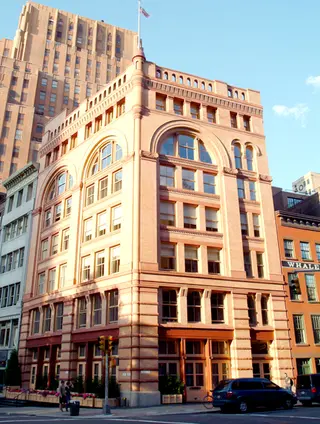 Carter Horsley
Carter HorsleyApr 24, 2012
Carter's Review
The very impressive and architecturally distinguished Mohawk Atelier Building at 161 Duane Street consists of two 19th Century commercial buildings that were combined to form 12 condominium apartments in 2009 by Joseph Pell Lombardi, a leading renovation architect and developer in the city.
The brick and sandstone Romanesque Revival building is notable for its boldly rusticated two-story base and three large arched windows on its sixth floor.
It has a prime TriBeCa location across Hudson Street from Duane Park.
Bottom Line
One of the best looking buildings in TriBeCa, the Mohawk Atelier is a small building that overlooks Duane Park and is close to City Hall and the World Trade Center site. It has only 12 large apartments and concierge service.
Description
The 8-story Romanesque Revival-style building on the northeast corner of Hudson Street at Duane Street has a corner turret topped by a flagpole.
The sixth floor has two very large arched windows fronting on Hudson Street and one large one on Duane Street next to two smaller arched windows on the eastern side of the building.
The building has a superb rhythm as broad piers have protruding rustication on the lower two floors surmounted by prominent bandcourses at the third and sixth stories. The seventh floor is stopped by a protruding small cornice of narrow arches beneath a row of larger open arches in a balustrade.
All windows are deeply inset to give the building a greater sculptural feel and its corner has a curved quoin to soften the edge.
The smaller, mid-block building has smaller windows and a pleasant but small cornice.
Amenities
The building has a 24-hour concierge.
This building has no garage and no sidewalk landscaping, but is convenient to public transportation.
Apartments
Kitchens have Subzero refrigerators, Bosch dishwashers, Viking gas ranges and steel cabinets.
Master bathrooms have brick-patterned walls, mosaic tile floors and single-slab countertops in rare honey Onyx.
The condominium apartments have three bedrooms and three bathrooms each and a penthouse apartment has a 50-foot-long living room with two fireplaces and two terraces.
The B Line units have a 25-foot-long living room with a working fireplace that opens onto a 15-foot-long dining room adjacent to a 13-foot-long pass-through kitchen. An upper level has three bedrooms and a play area.
Apartment 4A has an entry directly into a very large living room with a wood-burning fireplace that is adjacent to a large dining area adjacent to an angled, enclosed kitchen and a small bedroom with a curved corner wall that leads to a lower level with two more bedrooms.
History
One of the buildings, the taller, 8-story one, which is also known as 36 Hudson Street, was erected in 1891 in a very robust and lovely Romanesque Revival style designed by Babcock and Morgan.
According to an article by Skye H. McFarlane in the May 4-10, 2007 edition of downtownexpress.com, the building was built for Wood & Seleck confectioners. “The Mohawk’s creamsicle-colored brick is frosted with russet sandstone stripes and curling Ionic capitals,” the article observed.
It had been leased in 1996 by David Bouley and Warner LeRoy, the restaurateur, with an option to buy. Mr. Bouley and Mr. LeRoy exercised their option to buy with the intent of using it for a flagship restaurant and a cooking school. Mr. Bouley, however, sold the building and the adjacent mid-block building to Joseph Pell Lombardi, the architect and developer.
Mr. Lombardi combined the interiors of the buildings and installed new wood floors, modern appliances and an elevator. He also removed the white paint on the mid-block building to reveal its red paint and a large “Whalebone” banner sign. The building originally was built as a family residence. In the 1890s, the whalebone shop building housed Ye Olde Tavern on its ground floor.
In 2007, Mr. Bouley decided to buy the ground floor and basement of the Atelier building and a fifth-floor apartment as he already had a retail presence nearby.
In 2008, the renovation work was approved by the Landmarks Preservation Commission. It was completed in 2009.
The corner building is named the Mohawk Atelier because for many years it housed the Mohawk Electric Company.
The other, a four-story, mid-block building on Duane Street, was built in the 1840s. It is less ornate and served for many years as a whalebone cutting establishment.
Mr. Lombardi came to prominence as an architect and developer in 1979 when he converted the former Sinclair Consolidated Oil Company building at 55 Liberty Street into a cooperative apartment building. His more recent downtown projects include the Juilliard Building at 18 Leonard Street, the former United States Sugar Building at 79 Laight Street, the Ice House at 27 North Moore Street, and the Pearline Soap Factory Building at 414 Washington Street, among many others.

- Condo built in 1891
- Converted in 2007
- Located in Tribeca
- 12 total apartments 12 total apartments
- 10 recent sales ($3.1M to $10.6M)

 6sqft delivers the latest on real estate, architecture, and design, straight from New York City.
6sqft delivers the latest on real estate, architecture, and design, straight from New York City.
